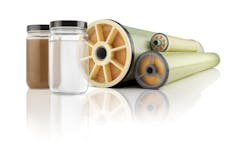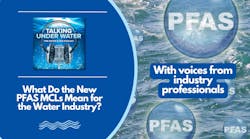The future of water reuse: How innovations in membrane filtration are helping conserve water resources
Increasing demands for clean water are straining water resources around the world. As the population continues to grow and more people move to urban areas, water utilities are facing multiple challenges related to water supply and water treatment operations. Water management at the local level cannot be overlooked, as the U.N. estimates that municipalities are responsible for 12% of all freshwater withdrawals.[1] In addition to facing increased water needs, utility companies are working to comply with new legislation regarding water usage, discharge treatment standards, and sustainability measures while facing an aging infrastructure and limited funds.
Many industries are also vulnerable to water shortages. Water is often used in manufacturing for cooling and cleaning, resulting in wastewater that must be treated before being reused or released back into the environment. Some contaminants are especially difficult to remove, such as small oil particles, and can create sludge that requires specialized disposal. Industrial wastewater purification methods must be cost effective and able to handle high volumes of wastewater at various temperatures and pH levels.
Access to efficient filtration is an important part of the development of the next generation of water recycling solutions. Advanced filtration membranes offer a highly effective, energy efficient treatment method, and manufacturers are continuously developing new technologies that meet the needs of industrial and municipal facilities and stay ahead of the ever-changing regulatory environment surrounding water conservation and reuse.
Challenges affecting the water sector
Climate change is impacting water supply as well as water quality. Severe storms and floods can compromise water sources by increasing the dispersion of pollutants, and rising sea levels are creating higher levels of saltwater intrusion. Prolonged droughts are reducing water availability, with multiple western states including Arizona, California, and Nevada imposing water conservation restrictions due to water shortages in the Colorado River Basin.
Water utility infrastructure is also in need of significant improvements and investment. In the latest Clean Watersheds Needs Survey, the U.S. Environmental Protection Agency (EPA) found that $630 billion will be needed over the next 20 years to deliver adequate clean water, with 55% of those funds needed for wastewater infrastructure.[2] Some of these needs stem from new water treatment standards including the Safe Drinking Water Act and legislation that defines maximum levels of chemicals like nitrogen and phosphorous. Effective filtration processes are crucial for removing these contaminants and providing safe, clean water sources.
Environmental considerations
Growing concerns for human and environmental health have also led regulatory authorities to focus on perfluoroalkyl and polyfluoroalkyl substances, known as PFAS. With their exceptionally strong molecular bonds, these compounds are referred to as forever chemicals. The EPA recently passed the PFAS National Primary Drinking Water Regulation which restricts six PFAS chemicals in water. Other legislation around the world also seeks to limit these chemicals, such as the REACH restriction proposal in Europe which addresses all uses of more than 10,000 per- and polyfluoroalkyl substances.
PFAS laws not only affect water discharge standards, but they also impact filtration technology directly. Because fluorinated compounds are so durable, they have been used as a common material for some membranes like polytetrafluoroethylene (PTFE). Membrane filtration manufacturers must develop alternative materials that are made without PTFE or other PFAS chemicals to address these emerging regulatory requirements.
As more robust ESG programs are adopted by more businesses and governments, the reduction of greenhouse gas emissions has become a top priority. Electricity production is a major contributor to emissions, and reducing total energy consumption is an important measure for sustainability goals.
The EPA reports that drinking water and wastewater plants are typically the largest energy users for municipal governments, responsible for 30 to 40% of total energy usage.[3] Water-specific groups, such as the U.S. Water Alliance, include water utilities focused on reducing greenhouse gas emissions in the water sector through climate mitigation strategies and sustainable water management. For membrane filtration manufacturers, energy efficiency is vital for any new technology.
Increasing demand
Applications that utilize membrane filtration applications are expanding due to advancements in membrane technology. Microfiltration (MF) and ultrafiltration (UF) processes can remove emulsified contaminants, oils and suspended solids across a wide variety of conditions. Unlike some wastewater treatment methods, membrane filtration does not require heating or chemical reagents. It can be used in high-pressure systems and on-site wastewater treatment environments like off-shore oil rigs, marine ship treatments, and industrial process water.
For the most stringent water quality standards, MF and UF filters can also act as a prefiltration step before reverse osmosis (RO) systems. RO is very effective at removing contaminants, but its membranes are particularly sensitive to fouling from oils, requiring costly maintenance and frequent replacements. MF and UF filtration membranes efficiently remove the damaging oils, protecting the RO membranes.
As municipalities seek to reduce freshwater withdrawals and, in some areas, build drought resiliency, graywater reuse has become more widespread. Graywater is water used in washing machines, sinks and showers and accounts for the majority of household water consumption. The latest membrane filtration technology is ideal for removing soaps and surfactants from this type of water, so it can be reused for irrigation, agriculture, and toilet flushing purposes.
High-performance innovation
In the past, membrane materials suffered from low flow rates and fouling, leading to frequent cleanings and long downtimes. Manufacturers have now developed advanced antifouling treatments that prevent oil, grease and other contaminants from fouling the membrane and filter elements. This helps reduce required maintenance and extend the life of the membrane, creating opportunities to save time and reduce costs.
Increasing filtration efficiency is also a high priority. The newest membranes provide improved durability and performance in a smaller footprint, making them easier to incorporate in existing facilities and require less floor space in new facility construction. Spiral wound configurations allow the water to pass through the filter in a more compact space, potentially lowering the number of filters needed and reducing energy use.
For operations that treat high volumes of wastewater, membrane filtration offers an efficient alternative to other bulk separation methods that require specialized equipment, high temperatures, or chemical reagents. Initiatives like graywater recycling can help significantly reduce freshwater needs for municipalities, easing the stress on local water utilities and helping areas that are facing water shortages. Membrane manufacturers are continuously developing new materials that increase flow, resist fouling, and help municipalities support sustainability goals in facilities and in effluent standards. Investment in new technology and large-scale field trials are essential to demonstrate the viability of water reuse.
Sources
[1] https://www.unwater.org/water-facts/water-food-and-energy
[2] https://www.epa.gov/system/files/documents/2024-05/2022-cwns-report-to-congress.pdf
[3] https://www.epa.gov/sustainable-water-infrastructure/energy-efficiency-water-utilities
About the Author

Lisa Walters
Lisa Walters is the global strategic market manager, specialty coatings and materials at PPG Industries.

